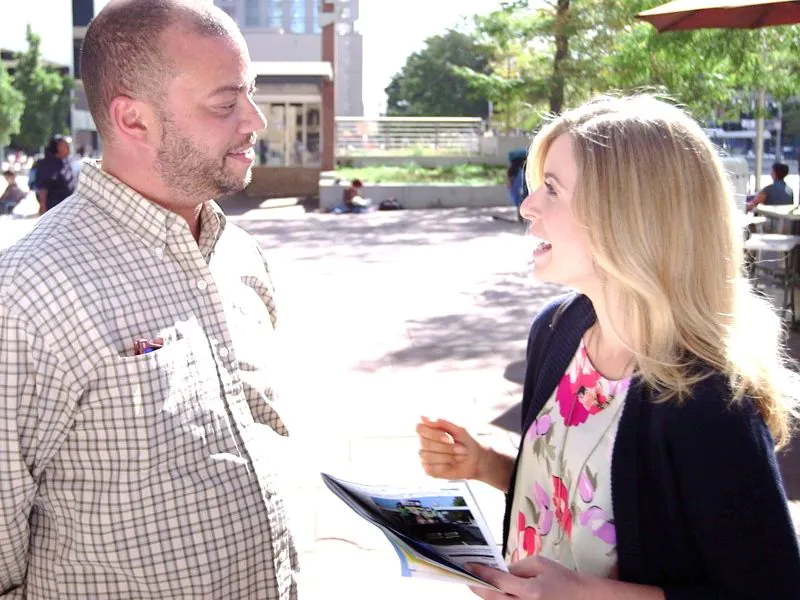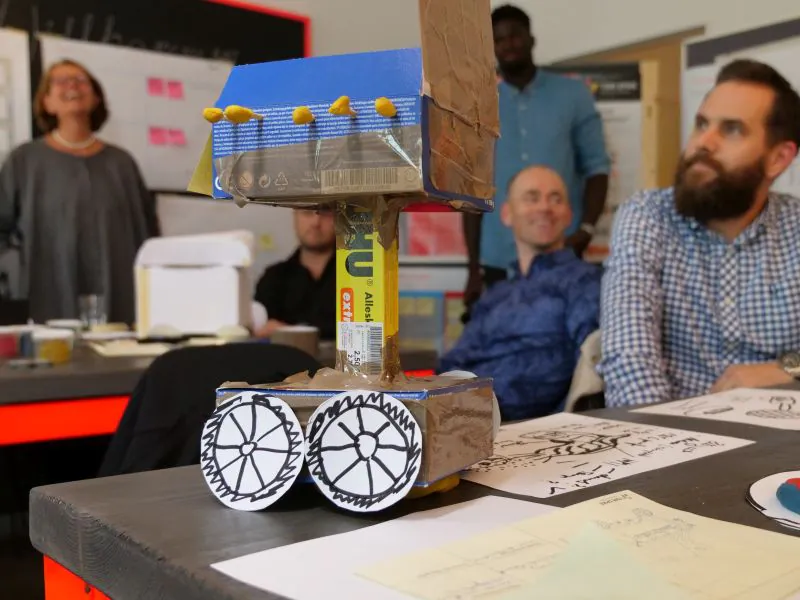Contacts & dates for customer interviews
Cold calling is not for everyone. And yet new contacts are essential for customer interviews. We provide you with top contacts and appointments.

When was the last time you saw a really new product? The first smartphone? Quite a while ago. The Segway? Very nice, but unfortunately a market failure. Series production was discontinued. The 3D printer? Actually quite old, but as a serious production process or “3D printer for the home” perhaps a relatively recent example. Indeed, product ideas are part of successful product innovation. And here we are right at the first big hurdle. Product innovation is the rarest and the one that most frequently fails among all types of innovation.
So how can promising product ideas be identified?
What do you do if brainstorming and creativity techniques prove unhelpful? If there are not too few ideas, but too many? What helps if previous product ideas have failed? Or if the ideas simply do not meet requirements?
A successful product idea is accepted by customers and, in the best case, is even loved. So why not involve customers in the development of new product ideas? Get input from those people you want to buy your product. But beware! You need to learn to ask the right questions:
If I had asked my customers what they wanted, they would have said: faster horses. [Henry Ford]
Henry Ford probably never said that. But nevertheless, it provides important insight. What does the next product have to look like? Customers do not know the answer. Why don’t they know? Because it’s not their job.
It’s not the customers’ job to know what they want [Steve Jobs]

With the right questions, however, interviews can still generate some great insights. For example, with questions about tasks that customers want to get done. Clayton Christensen calls these tasks “jobs” or “jobs to be done.” There are three types of these tasks.
Cold calling is not for everyone. And yet new contacts are essential for customer interviews. We provide you with top contacts and appointments.
You are currently viewing a placeholder content from Youtube. To access the actual content, click the button below. Please note that doing so will share data with third-party providers.
Sounds quite simple. So why don’t more companies talk to their customers when they want to develop new product ideas? There are many reasons for this.
How do you conduct customer interviews without having a finished product? How do you get good answers? And how do you get the right interview contacts?
The right questions generate important insights. But potential customers cannot provide all the answers. There are some things that only actual users knows. Because sometimes customers are “too close” and are too caught up in their own routines to see what is staring them in the face.
A small example:
This is what an alien visiting Earth in 1970 might have asked itself:
Humanity has managed to fly to the moon. And yet they are still carrying suitcases around by hand.
A valuable observation. Because suitcases on rollers had not yet been invented. An attentive and unbiased observer would have quickly recognized the problem when traveling. As a product developer and suitcase manufacturer, you know, of course, “that people will always have to carry their suitcases. After all, it’s always been like that.” The idea of the trolley came only centuries after the “development” of the suitcase.

Of course, observation alone is not enough. A pronounced “sense of the possible” is also necessary. An awareness that things can be different. And the experience that every problem can be solved if you really want to. Always.
Numerous methodologies use observation as a tool to arrive at new insights and product ideas. Shadowing in the context of Design Thinking is just one of them. In general, Design Thinking considers the understanding of problems as the most significant hurdle on the way to the idea.
“For those who understand the problem, the solution is obvious.”
Wherever users can be observed, observation is indeed a powerful tool. Yet, for technology innovation, e.g., in the development of the next fuel cell generation, it usually does not suffice as an approach.
A blind person has a hard time talking about color. And, indeed, many people cannot see the world through the customer’s eyes. Engineers develop first-class aircraft seats although they have never flown first class in their lives. Product managers design electronic components although they have never been involved in the design and development work undertaken by their customers. Business unit managers decide on the future of textile machines for the production of lace although they have never worn lace underwear.

Immersion in the customer’s world and how they use what they use. This approach is simple as it is effective for gaining impressions and insights. That is often much more than anyone can learn from interviews or mere observation.
Design Thinking and Customer Centricity are on everyone’s lips. Analyses are often frowned upon. Nevertheless, they provide valuable insights. Because in the end, the devil is in the details. Sweating out a few ideas and bringing them to market as products is something almost anyone can do. Let’s just look at the multitude of Internet of Things solutions. Many B2B markets are flooded. Everyone has an IoT platform. Everyone has a dashboard. Experimenting with digital solutions is certainly valuable. No question. But do these tools actually solve any problems in the end? Is the customer spending money on it? In most cases: No. A good product fits like glove. Even more so in B2B than in B2C. Achieving this is the goal. Analyses can help decisively.
An analysis toolbox includes:

Analysis is often criticized, especially before new ideas and products are developed. That sounds too much like a waterfall model. Better just start and see. And A/B testing is what everyone is talking about.
Analyses are controversial when it comes to ideas and innovations. That goes for testing and experimentation as well. Yet, testing and experimentation are tools that can lead to important insights – and not only later in the development process.

Testing and experimentation are particularly good at creating new product ideas even before a product is defined. Especially in rapid prototyping. When the team turns the first ideas directly into tangible, debatable objects. Through handwork. Maximum 30 minutes. Ideas for further products arise from target group feedback, through discussion within the team and through ‘thinking with your hands’.
Ultimately, it’s about testing assumptions: Is our idea of what the customer wants, needs, has, thinks right? Validation is the test and provides the answers. And, of course, new ideas. The tests are diverse. Click dummies, surveys, interviews, campaigns and lab experiments involving customers are just a few possibilities. But even apparently simple tinkering poses problems for many companies.
You are currently viewing a placeholder content from Youtube. To access the actual content, click the button below. Please note that doing so will share data with third-party providers.
Product ideas are successful if there is acceptance. No other type of innovation requires overcoming target group obstacles. The 5 ways presented here can help with this. By understanding. New understanding and new insights are the most important building blocks for new product ideas. This is one of the main reasons why product innovation is probably the rarest of all types of innovation. But don’t worry. Never before have the tools and experiences applicable to product ideas been as advanced as they are today. And even if the product idea doesn’t become a global sensation, all is not lost. Modest product ideas can become successful innovations. And the product idea doesn’t even have to be your own. In the following video, Gunter Dück pithily describes what needs to be done to actually lead product innovation to success: Hands-on.
Management consulting is a matter of trust. Let’s talk briefly about your challenge and find out whether we could work together.
Idea generation is a common pain point on the way to innovation success. TOM SPIKE accompanies ambitious companies through the innovation process. Idea generation is only one aspect of this. Ideas should fit the corporate strategy, appear feasible and profitable and offer the right level of innovation. TOM SPIKE relies both on the early involvement of corporate management and on the empowerment and support of the employees involved in the innovation project. In any case, the unprejudiced application of various tools and procedures is crucial. These include, for example, Lean Startup, Design Thinking, TRIZ, Business Model Innovation, Productization and Servitization.
As an innovation consultancy, we support companies and project teams on two different levels. Firstly, on a strategic level in order to answer the question “What innovations do we strive for as a company and how do we proceed with them?” Secondly, at the project and organizational level. There, we help teams to actually create innovations. Once, multiple times and consistently. Workshops, Coaching and Training focused on project issues are important building blocks. In order to provide relief for a company’s capacities, TOM SPIKE also takes over individual work packages and thus makes day-to-day business easier for employees.
When good advice is darely needed and ideas are rare, an...
Innovation is more than just a good idea “I haven’t failed....
There are certainly more than 7 reasons why an innovation process...
You are currently viewing a placeholder content from Google Maps. To access the actual content, click the button below. Please note that doing so will share data with third-party providers.
More Information